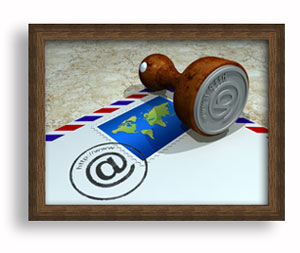The Good
Go ahead and take a stop watch to work today. Use it to time phone calls through out the day. If yours is like most businesses, you’ll find the average is in the 10 – 12 minute range. Then bring the stop watch in the next day and time how long the average email exchange takes. You’ll find it’s about 1 minute. If just two phone calls a day were handled by email you would save  about 2 hours per week per employee. In a four person office, that adds up to a day’s payroll for an employee. Email is good you say.
about 2 hours per week per employee. In a four person office, that adds up to a day’s payroll for an employee. Email is good you say.
The Bad
Of course we have to consider the number one bane of all in-boxes: spam. Spam is irritating at best, forcing you to delete unwanted offers for pharmaceuticals, ‘personal’ products or worse. Sometimes we lose track of legitimate emails in the clutter. At worst, spam can slow down mail servers and bring us to our communication knees.
Fortunately, protecting yourself from spam requires only a few simple measures. First, never give your email to anyone if you don’t know what they might do with it. Check out web sites for privacy policies. When in doubt, use an alternative email address. Those can be set up for free through Google, Yahoo or MSN, among others.
Never leave you email address ‘out there’ on your web site. Spammers use crawlers or bots, just like the search engines do. Spammers use bots to crawl web sites looking for email addresses they can add to their spam directories. Try to keep your email address behind a veil the bots can’t see through. Requiring a log in is one way to do that. But if you don’t have a way for users to automatically retrieve or reset their IDs and passwords you may end up with a lot of frustrated customers.
Lastly, you may want to consider using a spam filters. There are several on the market, some are free and most are inexpensive. They all work a little differently but most spam filters employ rules to score an email and mark it as ‘junk’ or ‘legitimate’. The better filters will catch nearly everything with minimum to no ‘false positives’. A false positive is a legitimate email that gets categorized as spam. If you use a filter, you should check your junk or bulk mail folder regularly to make sure legitimate emails aren’t missed.
The Unaddressed
In order to benefit from the time saving and efficiency email delivers, you need email addresses. How do you get them? The short answer is, as with most things, you don’t get something for nothing. Email is a convenience and expense saving for your agency, but what’s in it for your customer?
What is not intuitive is that you need to have a website worthy (from your customer’s point of view) of parting with an email address. A website that has meaningful content, security and sits at the center of client agency communications is the key to capturing email addresses. You can allow nearly free and unfettered access to your website but saving results, customizing content and preferences should be reserved only for registered users. And registration should include an email address. To see a demo website that will help your agency reap the benefits of email, go to http://www.confluencysolutions.com/cscoact/demo.php or choose the Demo Log In link at www.confluencysolutions.com.
Here are a few email collection tactics for your consideration.
Tactic 1: Ask for email addresses but provide assurances about how it will be used and how your customer or prospect will benefit. A privacy policy on your web site is a good place to start with assurances about how customer information, including email, will be used. Email should be required to access secure information on your website; that alone can be reason enough for a consumer to part with their address.
Tactic 2: Use email to link back to your website for efficiency and security. You can embed links from content at your agency website rather than retype information, that saves your employees time; it also saves your customers time. Using a link back to secure area on your website also avoids the inherently unsecure nature of email. Emails and attachments are like postcards – they are easy for many people to read. So there’s that security benefit again.
Tactic 3: Use contests and campaigns to gather emails. The contests and campaigns can be internal – small rewards to employees for gathering a certain number of emails (like Friday afternoon off). Or contests can be external – prizes based on random drawings for customers who register on your website; part of that registration should include a valid email address. Of course, you can’t really contemplate a email gathering campaign until you have addressed the assurances and benefits we noted in Tactic 1. But once you have, you should absolutely consider an email gathering campaign; an effective campaign can capture 30% to 50% or more of your customers emails in a several week burst.


2 Comments:
I wonder how many people really use email for their insurance business and how many of our clients would really use it - a lot of them are a retired or more blue collar.
there are over 150 million people with internet at home and over half that is high speed. More have access via their work place. So it stands to reason that a high proportion of your clients could use email, even if they are retired or work in non-professional roles. The key is using email thoughtfully, adding value and convenience when you do, not filling up in boxes. Another way to think about this is who your future customers are and by future I mean tomorrow and next week. You need to provide convenience and options they expect if you are to gain them as clients.
Post a Comment
<< Home